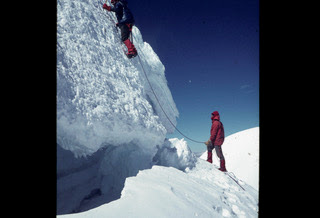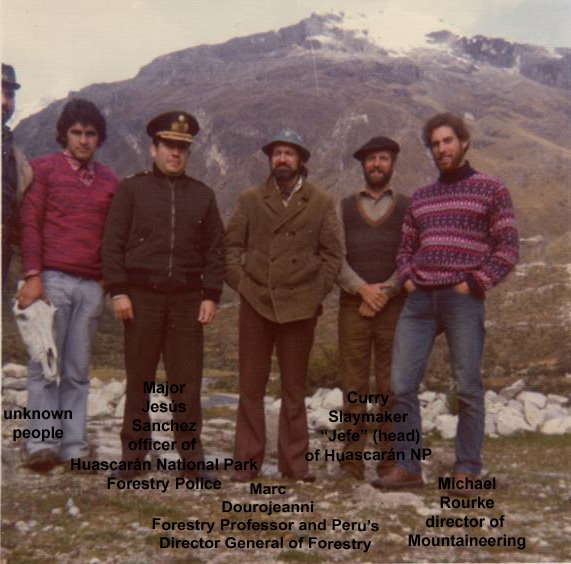Everything below was written by Murray Johns in an email to me on August 31, 2023. He finally found this blog “only” 16 years after I first started trying to locate him when I first encountered his name as someone who had climbed with Mike and Curry. This answers the big question I have had for years, “How and when did Mike and Curry get started doing serious mountaineering (andinismo)?”. When I knew Curry in 1973, he was frequently trekking around the area of the proposed Parque Nacional Huascarán (PNH) as part of his effort to establish its boundaries, but it was clear to me that he had not yet started serious mountaineering. From the following information, it now appears that Murray had a lot to do with teaching them mountaineering skills. Thus Murray, himself, was an important figure at the roots of what Mike and Curry did for mountaineering in the PNH. (Lew Scholl, 2023)
Neither Mike nor Curry had much experience in snow or ice climbing. But both were fit, strong and keen to learn, especially Mike. He came with me on several of the lesser climbs in the Blanca where he was quick to learn the basics of glacier travel, rope skills, axe work, snow camping and the like. When the opportunity presented, Curry joined us, learned 'on-the-job' so to speak, and it wasn't long before they were doing climbs on their own. They had access to good climbing gear, left with them by departing expeditions.
In the time I was living in Huaraz our climbs together included Pisco, Vallunaraju, Copa, Huascaran (north and south), Ranrapalca (See AAJ Article Here and Murray's Photos Below) and Rima Rima.
 |
Curry and Mike at Collon |
 |
Ranrapalca Base Camp |
 |
Ranrapalca North Face |
 |
Curry and Mike at Advance Base Camp |
 |
Curry Jumarring on Ranrapalca |
 |
Curry and Mike at Bivouac Site |
 |
Summit Pyramid -Center- from Bivouac Site |
 |
Curry and Mike on the Summit Pyramid |
 |
Murray and Mike at Advance Base Camp |
 |
Map for Orientation |
During 1975 in the course of their PNH work they both climbed together, plus with the local 'Club Andinista Cordillera Blanca' and other gringo climbers who happened along. Curry has his name on a new route on Hualcan. Both have their names on the first ascent of Ranrapalca's north face. It was Mike's initiative to organize the local porters and arrieros into a more professional and united group. They were both highly respected men in the local and expat community.
As for the accident, what more is there to say. I was back in Australia when that happened and didn't hear of it until weeks later. One account I read said Curry slipped, couldn't self arrest, went over the edge and his weight snapped Mike off his belay and into the air like a rag doll. Another account said Curry went through a cornice. I believe all was witnessed by their two companions following on another rope - one was Ryan ?, an ex Peace Corp lad who I knew but for whom I have no contact details.
In 2002 I went back to Peru to climb, with my son. But first I trekked to the eastern snow line in the Paria to pay my respects and thinking I might find something, I know not what, but to no avail. While there I encountered a Peruvian trekking guide. I raised with him Mike and Curry's names and it turned out he knew them well and had been involved in the search/rescue efforts. He was adamant that he and his fellow porters could have, and very much wanted to, gone up the Paria glacier to the face and possibly have found 'something'. However, they were prevented by the search hierarchy from doing so, and after all those years he was still somewhat bitter about that.
Back in Huaraz I heard, and what I dismissed as idle chatter and rumor mongering, that blood had been found on the floor of their tent. It will soon be 50 years since the accident, and with glacier retreat, it's likely evidence has now come to light. (Perhaps someone knows something?)
Mike was a very moral and upstanding man, a very strong character, with an always calm and reassuring demeanour. Very spiritual, had trained two years in a seminary and assisted in local church matters with the priests at the Los Pinos school, where he had previously taught PE. He was not a hard driven person, rather it was simply his work ethic and honesty that drove him forward in making life better for those his life happened to touch.
In the volunteer cohort there was frequent use of drugs but not once did I see Mike partake. Mentally he was too strong for that, very comfortable within himself and had no need for artificial highs. I recall him once saying that when standing on a summit you were one step from god. I only hope he found it.
Curry was a man who couldn't sit still, so much nervous energy and always on the go. Twice I recall when we had finished a climb and were waiting for our arriero to arrive next morning he couldn't wait and would be off down the quebrada and back to Huaraz and the PNH office.
What drove him was his love of nature, a passion to conserve the physical, environmental and cultural values of the Cordillera Blanca. He complimented this passion with adventure in the out-doors. His house in Huaraz was a focal point for expats and fun loving locals alike. Curry had personality and liked being surrounded by people. His death would have gutted so many friends and acquaintances.
At times with Curry there were hints he was running away from going back to the US and settling down. He did say, however, that he wanted to return to further his studies taking advantage of the subsidized Vet schemes.
As for the PNH, I was only ever on the periphery so I don't know much about its establishment. Clearly though, Curry was a leader (the jefe) in making the case for conservation. But there was also Dr Ponce in Lima. He was essential in having the regulations approved and cleared by the Agriculture Department's head office and taking that through to legislation. It was indeed a momentous day for Curry and Mike, and all those affiliated with the Park, when it was gazetted in 1975.
Writing this has triggered many memories of my time in Huaraz - good climbs and good times. But looking back on it all, what I valued most at the time was their friendship and good cheer. On occasions fate deals a fatal hand. This was just such a hand - two great guys snatched away and we know not why.
Vale Michael. Vale Curry.
Murray Johns, August 2023



